Research & Development: Creating the Shadow Hills Mastering Compressor Plugin for UAD and Apollo
Talk about a harmonic convergence.
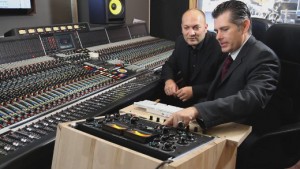
(l-r) Dirk Ulrich and Peter Reardon teamed to bring the SHMC perfectly into the virtual world. (all photos by Stefan Schönefeld)
One of the newest plugins for Universal Audio’s UAD platform and Apollo interface is the Shadow Hills Mastering Compressor. This justly famed piece of hardware stands as a flagship in Peter Reardon’s eccentrically obsessive line, designed to “expertly temper dynamics and tame transients.”
Adding to the meeting of minds needed to make the SHMC plugin was Dirk Ulrich, CEO of the equally inventive software developer Brainworx, a UAD Direct Development partner. Together with Reardon, Ulrich applied countless hours to ensuring that the $299 plugin would match up seamlessly with its $7295 hardware counterpart – a piece whose world-class signal path controls music dynamics in two stages: first with an Optical section, then with a Discrete (VCA) section. Both sections can be bypassed, providing a variety of compression sounds (Optical, Discrete, and combined).
The Shadow Hills/Brainworx collaboration resulted in a plugin that, like the hardware version, offers selection of three distinct output transformers (Nickel, Iron, and Steel) — taking the signal from “clean” to “colored” and “dirty” — as if selecting from the output stages of three distinct classic analog consoles.
How was this alchemy, from tangible to virtual, achieved? In our newest “Research & Development”, SonicScoop delved deep into the workflow of two top audio brainacs.
The Shadow Hills Mastering Compressor Plugin was a joint collaboration between Shadow Hills and Brainworx. How did the two of you divide the project workload?
Dirk: Obviously Peter and his team have developed the hardware. When we decided to work together we had several meetings to discuss what was important to Peter besides getting the sound right — the look and feel of the plugin so to speak.
The emulation and graphics are all done at Brainworx, but we sent Shadow Hills a test-plugin to try whenever we had reached certain milestones — for example when the Discrete Compressor played, or when Transformers worked, etc… This way Peter could give us his feedback during every step of the development.
When we were close to finalizing the process Peter visited us in Germany for a whole week to tweak the last bits of sound and graphics together.
Shadow Hills makes many hardware pieces. How was the Mastering Compressor selected as the first Shadow Hills piece to be emulated for the UAD format?
Peter: The Mastering Compressor is deeply entrenched in the highest echelons of the industry. The top mixers have it across their two buss, and you have heard it on a lot of modern music.
However the price point of this very esoteric compressor has kept it out of the hands of most working artists, engineers and producers. A digital reproduction was proposed to introduce this important tool to many whom would have otherwise never experienced it directly.
Dirk: It was THE unit that we wanted to model and that Peter and UA wanted to get as a plugin from Day One. It’s such a great-sounding and hot-looking device, it was an obvious choice.
Likewise, why did Shadow Hills elect to make this emulation available as a UAD plugin, as opposed to on another platform?
Peter: I have always had an affinity for Universal Audio’s products, both ancient and modern.
Dirk: We all felt that the Shadow Hills Mastering Compressor is a “perfect fit” for the UA platform and the UA users.
We knew it would be a “VIP release” as the hardware is one of the most-wanted and most expensive modern stereo compressors, used by so many A-list engineers around the world. Developing the plugin and working together with the experienced UA development and marketing team was something we all thought would make sense.
There were many details which we have discussed with UA during the development, which overall took almost a year.
Once the Mastering Compressor was selected for emulation, what were the various factors you had to consider – and balance — in creating the emulation?
Dirk: Well, as with every hardware unit we model we had to start working on the GUI to make the plugin look like its idol, and we always have to decide if we want to create a plugin that operates exactly like the hardware, or if we would want to add features, change operating levels, etc…
Peter wanted to make sure that any engineer who has used the hardware will be able to use the plugin just like he is used to operating the hardware. And of course we were focused on nailing the sound of the hardware as closely as possible — which was a hard task as the opto parts in the compressor are really hard to measure and analyze. This is what we spent most of the time on.
The hardware is a masterpiece so we decided to stick to the original concept wherever it was possible.
Peter: As Dirk has just stated, I wanted the experience of the plugin to be as close as possible to the physical compressor.
Obviously, qualitatively reproducing the sonics and the interface as close to perfect as modern technology allows was our first mission. This process began for me by exhaustively researching the best developer and engineers to help me to develop the emulation. In the end there was only one real choice: Brainworx and Michael Massberg.
I believe we have achieved our goal and all of our hard work really paid off. There were plenty of places where we could have stopped and said, “that is good enough” but we did not — that would have gone against all of our natures.
Does the Mastering Compressor plugin do everything the hardware version does? If not, how do you decide what to keep, what not to keep, and what to do differently in the plugin version?
Peter: We resisted the temptation to do tricky added features that are easy to do with plugins and stuck with the literal operations of the hardware. This meant all of the idiosyncrasies are included too, such as the compression cell impedance loading and zoomed tapers of the threshold and gain attenuators.
Dirk: The plugin captures all of the details that make the hardware sound like it does. We have captured the different transformer behaviors, the two independent compressors, the inductive level dependencies, the non-linear behavior of the various stages etc…
We are producing A/B comparison sound examples with the very unit we have modeled, and the plugin sounds just like the real thing if you use the hardware in a perfectly calibrated surrounding. Operating levels — input and output levels of soundcards vary by several dB! — are really important when comparing hardware and software versions.
How did you go about recreating the sound of the Shadow Hills Mastering Compressor, porting it from hardware to a digital emulation?
Dirk: We are starting with a “perfect model” of the hardware circuit which follows the original schematics, then we have to correct the theoretical values of the schematics to the real values we find when we measure components of the circuit, as most analog parts have certain tolerances.
Then we have to find out how some elements in the circuit affect other parts and capture these dependencies as well. We are not just measuring input and output of the units, we actually “build” the hardware circuit in code.
Peter: For me this approach was essential. Everything affects everything. This was not the easy method, but we could not compromise.
As you created the Mastering Compressor plugin, what were some unexpected surprises you encountered in the process along the way, either positive or negative?
Dirk: We knew it would be tough to find a proper model for the electro luminescent opto compressor elements. We spoke with experts around the globe – literally — and while there are many people who can tell you how these opto compressors sound, what their typical behavior is etc… there are basically no literature or technical specifications around that would help us find a formula for what´s going on inside these parts when they are hit by light.
So it wasn’t really a surprise that we had to spend a LOT of time on finding a proper model for these parts. We tested many different models that in theory would behave similar to the components used in the hardware, but in reality only one of the models worked right in the digital domain.
Peter, you made multiple presets for the plugin version. How are those presets conceived, and which ones did you choose to include?
Peter: Presets for compressors are very dicey. Your program material will have a lot to do with where you settings should begin.
That being said, the Mastering Compressor has many diverse capabilities for subtle and brutal applications. The presets are meant as an introduction to some of the usages of the compressor.
Dirk: Peter is a well-respected audio engineer and producer who has recorded some decent and famous acts, and he has used the hardware for years, so he was the perfect person to make the presets.
The SHMC is unit that can give you several very different sounds if you tweak it right: It´s great for subtle changes on masters, but it also can pump life into drum tracks like hell, or it can be used to just color your audio signal by switching off the compressors and only use the transformers. Peter chose some great settings for mixing and mastering situations, but also for individual tracks — guitars, vocals, piano, etc. — or groups/busses.
Now that the process is completed, what would you say are the most challenging aspects of designing a plugin variation of a hardware product?
Dirk: Brainworx has a history of emulating some of the most complex analog audio tools ever designed, and our team is learning with every new project, of course.
You have to be a great programmer to make great plugins, but you have to be a great programmer with an insanely deep knowledge and understanding of analog audio to be able to make great emulations of hardware units.
Non-linear behavior and dynamics in general are much harder to emulate than a simple and pure filter, that´s a general rule. Then again, we occasionally run into tough-to-model parts of schematics in units that were estimated to be straightforward projects.
A good portion of our work is research really. We are constantly trying to put the theory of the schematics together with the reality of our measurements and listening experiences.
Peter: This was an ambitious project, that from the outset I did not know if I would complete. If the results did not pan out we would not have released the emulation.
This was my first foray into software and you never know how things will turn out. But I had the best team and a tremendous amount of confidence in their experience and capabilities. We never compromised — that can be difficult. I believe the results speak for themselves.
On the flipside, what would you say are the most rewarding aspects of designing a plugin variation of a hardware product?
Dirk: You know, it´s really a GREAT feeling if you are tweaking a plugin after several months of work, sitting besides the developer of an analog hardware unit in front of some high-quality studio speakers in an acoustically treated room, and nobody in the room is able to tell a difference between the hardware and the software anymore.
The months we spend on getting there are filled with enlightening and frustrating moments alike, just like with any ambitious project, I guess. But to be able to capture the sound of a really cool and great-sounding analog unit “forever” by transferring its DNA into audio is a rewarding process for fans of analog audio. And that´s what we are at Brainworx.
Peter: I enjoyed immensely working with the Brainworx team. In our path to where we have arrived we consulted with some of the engineers who worked on the original development of the hardware, Ian MacGregor and Fred Bova. Revisiting with them and being inspired by their knowledge and creativity was wonderful.
Sounds like it was a real journey! Lastly, let’s look at the end user: What’s different about the way engineers/producers/artists can use the plugin version of the Shadow Hills Mastering Compressor, as opposed to the original hardware version? And what remains the same?
Peter: Multiple instances should liberate the Mastering Compressor from its dedicated position on the mix, and show the creative ways it can shine on the drum buss and for tracking.
Dirk: I really believe that you can use the plugin without even looking at the manual if you have ever used the hardware. Every switch and knob on the plugin GUI does what you expect it to do, and the sound it gives you is just what you’re used to if you know the hardware well.
The great difference is, as with every plugin, that it is recallable, automatable, and affordable, even if you want to use the processor on 48 channels. We have actually sold many, many plugins of hardware emulations to owners of the original hardware units, so they can use the unit they love on more tracks.
— David Weiss
Please note: When you buy products through links on this page, we may earn an affiliate commission.







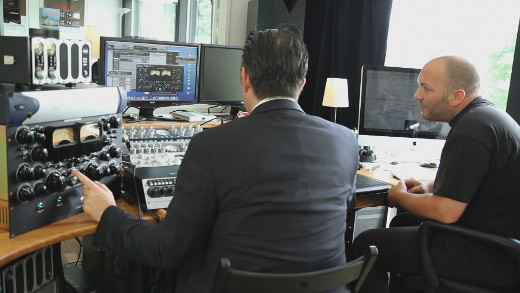
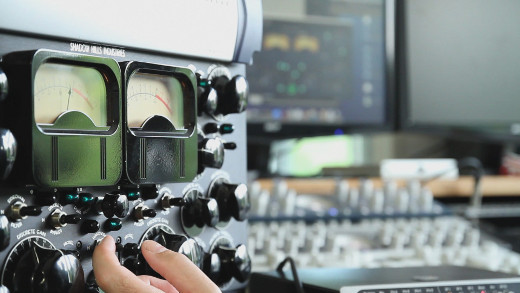
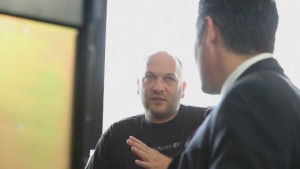
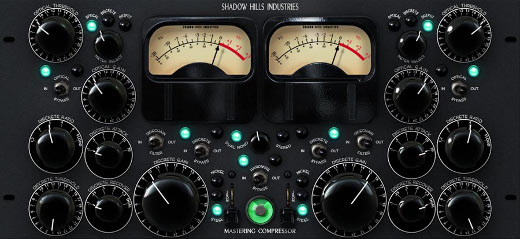
MIB
December 11, 2012 at 2:02 pm (11 years ago)No geek cred for guys in suits. Boo! Seriously, engineers in suits? WHERE?!
audientltd
December 11, 2012 at 2:55 pm (11 years ago)Love it! Great work guys…
Barry Wood
December 11, 2012 at 3:53 pm (11 years ago)Check out the Shadow Hills site, the suit is part of the whole Shadow Hills motif.
leftletter
July 4, 2013 at 1:10 am (11 years ago)kidding me? that guys top of the game, do some homework, you sound ignorant.